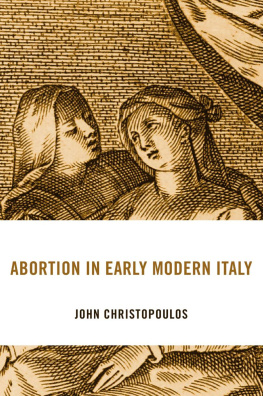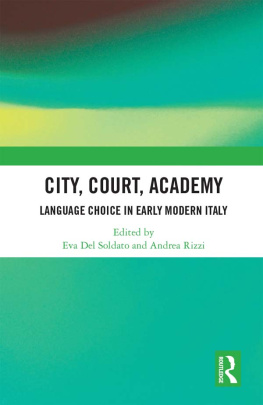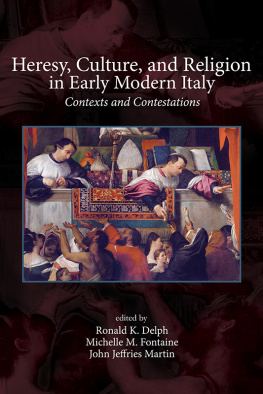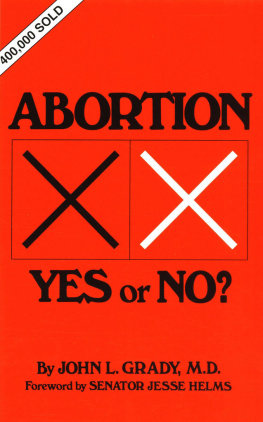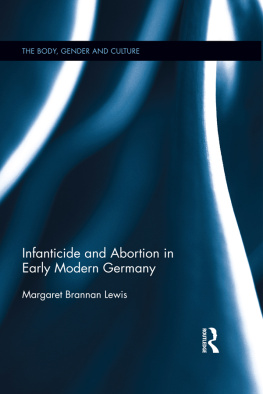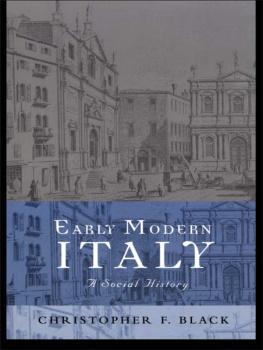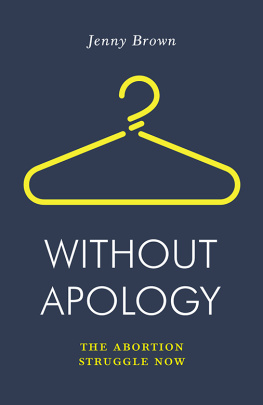Copyright 2021 by the President and Fellows of Harvard College
All rights reserved
Printed in the United States of America
First printing
Library of Congress Cataloging-in-Publication Data
978-0-674-24936-3 (ePub)
978-0-674-24937-0 (Mobi Pocket)
978-0-674-24938-7 (PDF)
Jacket Design: Jill Breitbarth
Jacket Photos: Pietro Paolo Magni Discorsi intorno al sanguinare i corpi humani (Rome , 1584), courtesy of Hathi Trust Digital Library.
Names: Christopoulos, John, 1983- author.
Title: Abortion in early modern Italy / John Christopoulos.
Other titles: I Tatti studies in Italian Renaissance history.
Description: Cambridge, Massachusetts : Harvard University Press, 2021. | Series: I Tatti studies in Italian Renaissance history | Includes bibliographical references and index.
Identifiers: LCCN 2020017721 | ISBN 9780674248090 (cloth)
Subjects: LCSH: AbortionItalyHistory16th century. | AbortionItalyHistory17th century. | AbortionMoral and ethical aspectsItalyHistory. | AbortionReligious aspectsHistory. | AbortionLaw and legislationItalyHistory.
Classification: LCC HQ767.5.I8 C57 2021 | DDC 362.1988/80094509031dc23
LC record available at https://lccn.loc.gov/2020017721
I n sixteenth- and seventeenth-century Italy, women procured abortions and had them forced upon them. Single and married women, both elite and non-elite, had abortions when they believed enduring pregnancy and childbirth to be harmful: abortions were had to conceal sexual relations, avert social and material hardship that could accompany children, and alleviate potentially dangerous health issues. A variety of healers provided services and sold products to these ends. Sometimes abortion was procured intentionally through medicines and physical traumas; sometimes it was an accident, caused by unintended interventions, labors, violence, illness, or health-related complications. Sometimes abortion worked and recovery was swift; other times it didnt work and women continued their pregnancy to term; sometimes it resulted in physical harm and death, not unlike childbirth. In some circumstances, abortion was considered a sin and a crime; in others it was not. Sometimes abortion resulted in scandal, prosecution, and punishment; often it was responded to with sympathy and supportit was forgivable, acceptable, deemed necessary, and relatively unproblematic. More often than not abortion was ignored, something individuals, communities, and authorities turned a blind eye to. Despite increasingly heated rhetoric and new legislation seeking to change its meanings and regulate its practice, abortion remained widely sought, accessible, and generally tolerated. In early modern Italy, abortion was a fact of life.
These statements might surprise those who come to this book assuming that, at this time and place, abortions could not be had and therefore were not had, except by the very desperate, willing to risk life and limb. Early modern Italy was, after all, the headquarters of the Catholic Church and in the midst of an intense program of moral and social reform, commonly referred to as the Counter- or Catholic Reformation. Because the Catholic Church maintains a strict prohibition on abortion today, it is easy to assume it always has. The current Catechism of the Catholic Church makes such a historical argument: Since the first century the Church has affirmed the moral evil of every procured abortion. This teaching has not changed and remains unchangeable.
Indeed, current-day expectations regarding abortion in the premodern past are likely shaped by assumptions about the power of authorities and institutions, such as the Catholic Church, and the extent to which they could condition the behaviors and mentalities of their subjects. To support such an assumption, one need only read the famous and infamous declaration of Pope Sixtus V: issued in 1588, Sixtuss bull Against those who Procure, Counsel and Consent in any way to Abortion unconditionally prohibited induced abortion, which he defined as the untimely death and killing of a soul created in the image of God and of children before they could receive from nature their portion of lightan abhorrent and evil act. Sixtus declared that those procuring, administering, or assisting in abortion were automatically excommunicated from the faith and to be prosecuted by ecclesiastical and secular tribunals as true murderers who have actually and really committed homicide. For over four hundred years, theologians, scholars, and general commentators interested in the history of abortion have looked to Sixtuss bull as the foundations of modern Catholic policy on the subject.
However, people in the sixteenth century did not always believe or do what their leaders desired; nor were leaders consistent in the absolutism of their positions. Only three years after the abortion bull, the new pope Gregory XIV issued a moderation softening Sixtuss stance, which was deemed too radical and unimplementable. And the historical record is full of individualswomen and men, lay and clerical, ordinary and elitewho did not agree with the definition of abortion as an unequivocally abhorrent and evil act. In the historical record, we find individuals who terminated their own and other womens pregnancies and refused to accept excommunication or found it irrelevant. We find communities accepting, helping, and ignoring individuals who sought and had abortions. We find authorities refusing to prosecute procurers and practitioners, or punish them as true murderers. We will meet many of these individuals in the pages of this book.
How might we try to explain the gap between prescriptions (and popular lore) and practices surrounding abortion in the early modern past? As always, if we take the official statements of authorities as our only guides, we would believe the worlds they desired and tried to createthrough legislation, other statements of shoulds and musts, and threats of draconian disciplineactually existed. In doing so, we would erase the presence, agencies, and moralities of myriad individuals who made up the world, individuals who believed and acted differently. In short, we would ignore reality. When we expand our source base and adjust our methodology with the aim of recovering the thoughts, practices, and experiences of as many individuals as possible, especially women, we discover a society that is, not unlike our own, far more complicated. We see that early modern Italy was not an absolute and timeless antiabortion culture, that exemplary Catholic Italian and traditional family society some today might wish to conjure for political ends. Rather, Italians at all levels of society held many views on abortion, and their responses to its practice varied. Diverse actors were involved in the conversation, and a diverse set of ideas and concerns were being discussed and debated. Following a variety of actorsfrom poor rural and urban working women to aristocratic matrons, from university educated physicians and apothecaries to midwives and barbers, and from parish priests and confessors to judges and popesreveals that sixteenth- and seventeenth-century Italians were ambivalent about abortion. By ambivalent I mean having mixed feelings, being pushed and pulled in different directions by powerful compulsions that were often at odds with each other. This book tries to understand that ambivalence. It resists the impulse to homogenize early modern society and its institutions by investigating the variety of meanings Italians gave to abortion. It asks how and why meanings were created, reproduced, modified, and challenged in theoretical discussions, statements of doctrine, policy and law, ecclesiastical and civic politics, medical practices, and everyday life. Above all, it strives to foreground womens perspectives on this topic. Then as now, there was no one response to abortion. Early modern Italians attitudes toward and experiences of abortion were as intricate and complicated as our own.


